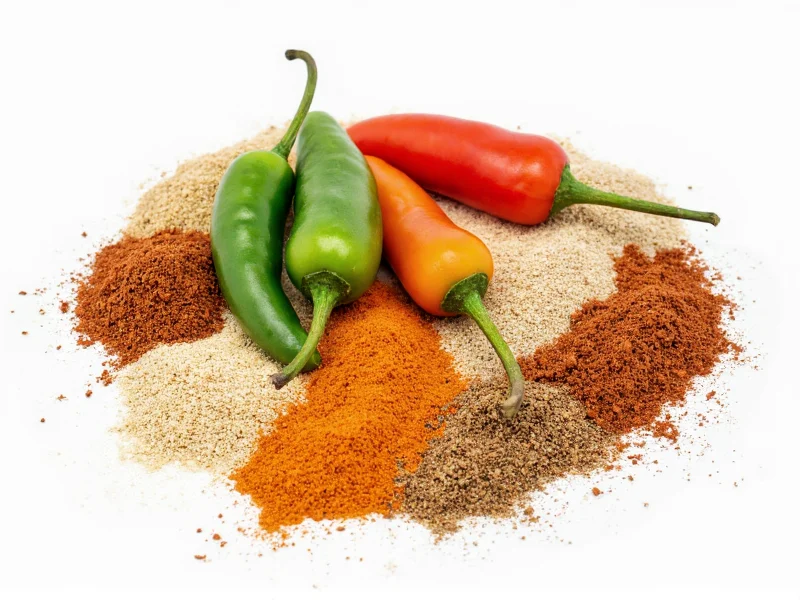Understanding where jalapeños fall on the spice spectrum helps home cooks and food enthusiasts make informed decisions in the kitchen. These popular peppers serve as the gateway to spicier varieties for many people, but their heat level can surprise those expecting consistent mildness.
Decoding the Scoville Scale for Jalapeños
The Scoville scale measures chili pepper heat by determining capsaicin concentration—the compound responsible for that burning sensation. Developed by pharmacist Wilbur Scoville in 1912, this measurement system remains the standard for quantifying pepper spiciness.
Jalapeños occupy a specific range on this scale, but their position isn't fixed. Unlike standardized products, each jalapeño develops its unique heat profile based on environmental factors and biological variables. This natural variation explains why one jalapeño might barely tingle your tongue while another delivers a significant kick.
What Determines Jalapeño Heat Levels?
Several key factors influence how hot your jalapeño will be:
- Ripeness: Green jalapeños are generally milder, while red (fully ripe) varieties often pack more heat
- Stress conditions: Peppers grown in less-than-ideal conditions (drought, temperature extremes) typically produce more capsaicin
- Seeds and membranes: The white pith and seeds contain most capsaicin—removing them reduces heat significantly
- Genetic variation: Different jalapeño cultivars have distinct heat profiles
Interestingly, commercial growers sometimes select for milder varieties to appeal to broader markets, while specialty growers might cultivate hotter strains for spice enthusiasts. This explains why supermarket jalapeños often feel more consistent in heat than farmers' market varieties.
Jalapeño Heat Compared to Other Common Peppers
| Pepper Variety | Scoville Heat Units | Heat Level Comparison |
|---|---|---|
| Bell Pepper | 0 SHU | 0 times jalapeño heat |
| Poblano | 1,000-2,000 SHU | Half as hot as jalapeño |
| Jalapeño | 2,500-8,000 SHU | Baseline |
| Serrano | 10,000-23,000 SHU | 2-3 times hotter than jalapeño |
| Habanero | 100,000-350,000 SHU | 15-40 times hotter than jalapeño |
This comparison shows how jalapeños serve as a reference point between mild and extremely hot peppers. When following recipes that call for jalapeños, understanding these relative heat levels helps you make appropriate substitutions based on your spice tolerance.
Historical Evolution of Heat Measurement Standards
The methodology for quantifying jalapeño heat has evolved significantly, impacting commercial cultivation and consumer expectations. Modern measurements reflect centuries of agricultural refinement:
| Era | Measurement Approach | Impact on Jalapeño Production |
|---|---|---|
| Pre-1912 | Subjective tasting panels with no standardization | Extreme inconsistency in commercial crops; jalapeños often mislabeled as "mild" despite significant heat variation |
| 1912-1980s | Scoville Organoleptic Test (human taster dilution) | First consistent range established (2,500-8,000 SHU); enabled basic consumer labeling but remained unreliable for commercial processing |
| 1980s-Present | HPLC laboratory analysis of capsaicinoids | Precise SHU measurement allows modern breeding programs to develop consistent-heat cultivars (e.g., Jalafuego at 4,500 SHU) |
This progression from subjective tasting to chromatography has transformed jalapeños from unpredictable garden produce to a standardized culinary ingredient. According to the USDA's Agricultural Research Service, HPLC testing now enables seed developers to target specific heat profiles within 5% accuracy, explaining the consistent mildness of supermarket jalapeños compared to heirloom varieties.
Source: USDA ARS Capsaicin Quantification Methods
Practical Implications of Jalapeño Heat Levels
Knowing the jalapeño pepper spice level isn't just academic—it has real kitchen applications. The moderate heat of jalapeños makes them versatile for various cooking techniques:
- Raw applications: Perfect for salsas, guacamole, and salads where you want noticeable but not overwhelming heat
- Cooking: Heat diminishes slightly when cooked, making them ideal for stuffed peppers, poppers, and sauces
- Pickling: Pickled jalapeños often taste milder due to vinegar's neutralizing effect on capsaicin
- Preserving: Dried jalapeños (known as chipotles when smoked) concentrate the heat, requiring less quantity in recipes
For those sensitive to spice, removing the seeds and white membranes can reduce the jalapeño's heat by up to 80% while preserving flavor. Conversely, leaving these parts intact maximizes the pepper's kick for spice lovers.
Contextual Boundaries: Optimal Applications and Limitations
Jalapeños excel in specific culinary contexts but have clear limitations that affect recipe success:
- Ideal scenarios:
- Beginner-friendly spice introduction (heat detectable but rarely overwhelming)
- Recipes requiring structural integrity (e.g., stuffed peppers where shape retention matters)
- Vinegar-based preparations (pickling, ceviche) where acidity moderates perceived heat
- Critical limitations:
- Unsuitable for high-heat commercial sauces (requires habanero or ghost pepper for SHU >100,000)
- Heat inconsistency makes them unreliable for standardized food manufacturing
- Lose distinctive flavor profile when dehydrated beyond 10% moisture content
Texas A&M's AgriLife Extension emphasizes that "jalapeños provide optimal heat-flavor balance for home cooking but should be avoided in applications requiring precise, scalable heat output." Their research shows that only 68% of commercial kitchens achieve consistent results when substituting jalapeños for cayenne in spice blends due to natural SHU variation.
Source: Texas A&M AgriLife: Hot Pepper Applications Guide
Safety Tips for Handling Jalapeños
Even with their moderate heat rating, jalapeños can cause discomfort if mishandled. Follow these safety guidelines:
- Wear gloves when handling multiple peppers or if you have sensitive skin
- Avoid touching your face, especially eyes, while working with peppers
- Wash hands thoroughly with soap and water after handling (alcohol-based sanitizers can spread capsaicin)
- Use separate cutting boards for peppers to prevent cross-contamination
- If experiencing burning sensation, dairy products like milk or yogurt provide relief better than water
Understanding the jalapeño pepper spice level helps you anticipate how these peppers will perform in your recipes. Whether you're making mild stuffed jalapeños or fiery hot sauces, knowing what to expect from these versatile peppers ensures better culinary results.











 浙公网安备
33010002000092号
浙公网安备
33010002000092号 浙B2-20120091-4
浙B2-20120091-4